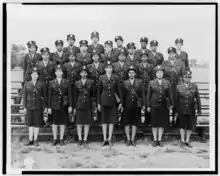Mary L. Petty
Mary Louise Petty (January 4, 1916 – September 14, 2001) was an American army nurse during World War II. Petty was the first Black member of the U.S. Army Nurse Corps to achieve the rank of captain. She supervised a nurse training program at Fort Huachuca, and led the first group of Black nurses sent to serve in Europe in 1945.
Mary L. Petty | |
|---|---|
 Mary L. Petty in uniform, from a 1944 publication | |
| Born | January 4, 1916 Seattle, Washington |
| Died | September 14, 2001 (aged 85) Illinois |
| Occupation(s) | Nurse, nursing educator |
| Known for | 1st Black captain in US Army Nurse Corps (1944); led 1st contingent of Black nurses sent to Europe in WWII (1945) |
Early life
Petty was born in Seattle, Washington and raised in Chicago, where she graduated from Wendell Phillips High School. She graduated from the Freedmen's Hospital School of Nursing in 1940.[1]

Career
Petty worked in hospitals in Virginia and New York after her training. She joined the US Army Nurse Corps in 1941.[1] She served at Fort Bragg and then at Tuskegee, where she served under chief nurse Della H. Raney.[2][3] Petty was the first Black member of the U.S. Army Nurse Corps to achieve the rank of captain.[4][5] In early 1944 she was assigned to head a training center for Black nurses at Fort Huachuca, Arizona.[6] In 1944, she led the first contingent of 63 Black American army nurses sent to serve in Europe.[7][8][9]
Petty was also active in the National Council of Catholic Nurses.[10]
Personal life
Mary L. Petty gave an interview in 2001 to the Chicago Tribune, about her "mostly fond memories" of being an Army nurse; at the time she was described as "nearly blind and suffering from depression and other maladies".[11] She died a few months later, in September 2001, aged 85 years. Her grave is in the Abraham Lincoln National Cemetery in Illinois.
References
- "Capt. Mary Petty Heads First Negro Nurse Training Center". The New York Age. 1944-07-15. p. 4. Retrieved 2022-02-26 – via Newspapers.com.
- Homan, Lynn; Reilly, Thomas (2018-12-14). Black Knights: The Story of the Tuskegee Airmen. Arcadia Publishing. ISBN 978-1-4556-0125-7.
- "'Skegee Air Base Gets First Negro Nurses in Army". Jackson Advocate. April 11, 1942. p. 3. Retrieved February 26, 2022 – via NewspaperArchive.com.
- "Negro Nurses". The American Journal of Nursing. 44 (5): 477. 1944. doi:10.2307/3456333. ISSN 0002-936X. JSTOR 3456333.
- "Capt. Mary Petty is Honored by Co-Workers at Banquet". Apache Sentinel. April 14, 1944. p. 3. Retrieved February 26, 2022 – via Arizona Memory Project.
- "Negro Nurses" National Negro Health News (April-June 1944): 7.
- "First Negro Nurses Arrive in Europe, Led by Capt. Petty". Indianapolis Recorder. July 7, 1945. p. 8. Retrieved February 26, 2022 – via Hoosier State Chronicles.
- Mullenbach, Cheryl (2013). Double Victory: How African American Women Broke Race and Gender Barriers to Help Win World War II. Chicago Review Press. p. 130. ISBN 978-1-56976-808-2.
- "First Negro Nurses Arrie in European Theater of Operations". Opportunity. 22: 178–179. Fall 1944.
- "Convention Bound". Apache Sentinel. May 19, 1944. p. 7. Retrieved February 26, 2022 – via Arizona Memory Project.
- Gregory, Ted (2001-05-28). "Forgotten War Nurses Keep Their Story Alive". Chicago Tribune. pp. 1, 16. Retrieved 2022-02-26 – via Newspapers.com.
External links
- A photo of Petty with another Black nurse in World War II, in the Schomburg Center for Research in Black Culture, New York Public Library
- First Negro Nurses Land in England (August 21, 1944), US Signal Corps photo in the Library of Congress